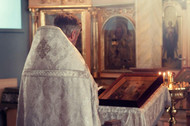Essential Accessories Clergy Must Have When Wearing Apostle Attire
Oct 30th 2023
Apostle attire holds a significant place in the religious traditions of many denominations. The garments worn by clergy members, especially apostles, are not only symbolic but also carry deep spiritual meaning.
To complement and enhance the impact of the apostle attire, there are essential accessories that clergy members should consider incorporating into their ensemble.here are the crucial accessories that clergy must have when wearing apostle attire.
Significance of Apostle Attire
Attire for apostle priests and pastors typically consists of distinctive robes, stoles, and other garments that signify the clergy's role within the church community. These garments often carry rich symbolism and connect the clergy to their spiritual responsibilities.
However, to complete the overall look and reinforce the visual impact, the right accessories play a crucial role.
Clergy accessories hold significant importance for individuals donning apostle attire. These accessories, ranging from stoles and chasubles to pectoral crosses and miters, hold both symbolic and functional value within religious contexts.
Symbolically, clergy accessories convey the wearer's role, status, and religious affiliation. They often feature intricate designs, colors, and symbols that signify the wearer's rank and the liturgical season.
For apostle attire, these accessories help recreate the historical aesthetic associated with the apostles' teachings, enhancing the spiritual ambiance of worship.
Functionally, clergy accessories aid in conducting religious ceremonies effectively. Stoles and chasubles, for instance, help differentiate between roles during Mass, signifying the celebrant, deacon, or other roles.
Pectoral crosses are emblematic of faith and leadership. Miters, worn by bishops, signify their authority and apostolic succession. These accessories also create a sense of reverence and respect, helping the congregation connect more deeply with the spiritual message being conveyed.
In essence, clergy accessories are vital components of apostle attire, bridging the gap between the spiritual and the practical. They serve as conduits of tradition, spirituality, and communication, enriching the religious experience for both clergy and worshippers alike.
Essential Accessories for Apostle Attire
Stole or Scarf
The stole is a fundamental accessory in apostle attire. It is worn around the neck and symbolizes the authority and responsibility of the clergy. The color and design of the stole often correspond to the liturgical season or the occasion.
Cincture or Cord
A cincture or cord is a rope-like accessory tied around the waist to secure the robe. It serves both a practical purpose, keeping the robe in place, and a symbolic purpose, representing the clergy's commitment to their faith and duties.
Pectoral Cross
Worn around the neck, a pectoral cross is a significant accessory that signifies the spiritual leadership of the clergy. It serves as a reminder of the sacrifices made by Christ and represents the clergy's dedication to their congregation.
Ring
A distinctive clergy ring is often worn as a symbol of authority and commitment. The ring may bear an intricate design and may even be passed down through generations.
Mitre
In some traditions, a mitre is an elaborate ceremonial headpiece worn by bishops and archbishops. It represents their authority and spiritual leadership. While not worn daily, it's a key accessory for special occasions.
Chasuble
This outer liturgical vestment is often worn over the robe. It's essential to have chasubles that correspond with the liturgical seasons, and they are often adorned with intricate designs and embroidery.
The Importance of Adornments
Accessories are not merely decorative elements but hold deep spiritual significance. They communicate the clergy's commitment to their faith, leadership role, and the sacred rituals they perform. The proper choice of accessories can also convey a sense of humility, modesty, and reverence.
While many accessories have symbolic meanings, practicality and comfort are also important factors. Accessories like clasps, pins, and fasteners ensure that the attire remains secure during various activities, such as preaching, leading services, and performing sacraments.
Historical and Cultural Variations
It's important to note that the accessories worn with apostle attire can vary based on historical traditions and cultural influences. Different denominations may emphasize certain accessories, while others may have unique adornments that hold specific meaning within their faith community.
Across Christianity's history, different denominations developed unique styles. Eastern Orthodox clergy may wear elaborate vestments and ornate crowns, reflecting Byzantine influences. Roman Catholic bishops often don distinctive miters and pectoral crosses. Protestant traditions lean toward simpler designs, emphasizing humility.
Cultural variations abound, with African, Asian, and Indigenous communities infusing local motifs. Colors, patterns, and materials differ based on liturgical seasons and regional aesthetics. These variations reveal how apostle accessories adapt to diverse historical, theological, and cultural contexts, reflecting the richness of global Christianity and its expressions.
Apostle Attire Goes with the Right Accessories
Apostle attire is more than just clothing; it's a representation of spiritual commitment, leadership, and reverence. Essential accessories complete the ensemble and deepen the symbolism associated with clergy roles.
These accessories not only enhance the visual impact but also serve as reminders of the clergy's sacred duties and their connection to their faith and congregation. Divinity Clergy Wear can help you find the right accessories for you, no matter which Christian denomination you belong to.
